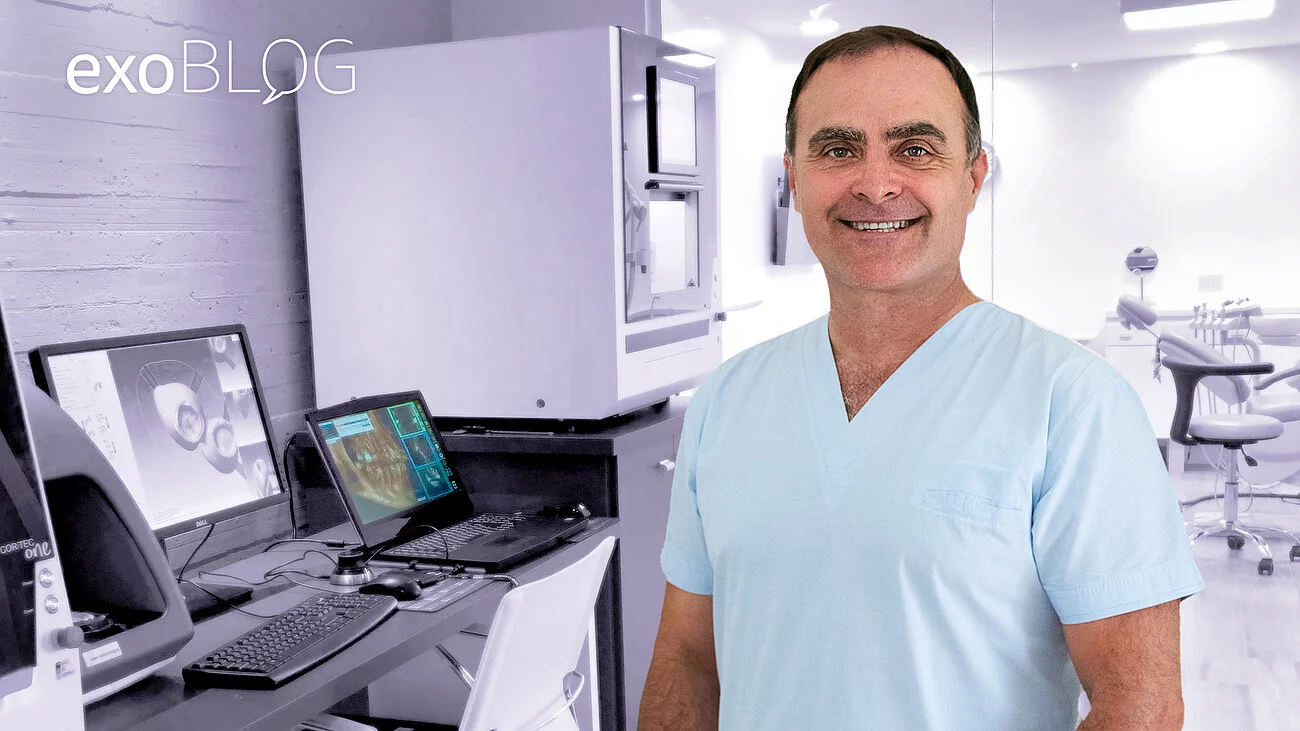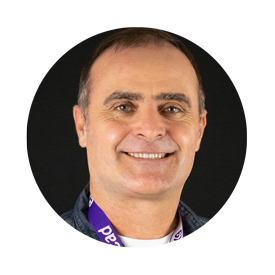Complex implant restorations simplified
Less chair time for patients, greater precision and more predictable results in fewer steps—those are just a few reasons why Dr. Marcelo Pérez Giugovaz can’t imagine his work as an implantologist without exocad. From his office in Buenos Aires, Argentina, Marcelo explains how DentalCAD and exoplan create an ideal workflow for even complex restorations.
Q: Why did you go into dentistry?
A: I went into dentistry because I liked the possibility to create positive changes esthetically for the patients who needed it. I completed my entire degree program alongside the woman who later became my wife, Dr. Adriana Giugovaz. We studied, attended, and graduated together on the same day. As the years go by, I find I become more and more enthusiastic about dentistry.
Q: When did you first embrace digital workflows and why?
A: My first steps into digital were in 2004 with the Procera system and the contact surface scanner for alumina crowns with excellent adaptation. At that time, metal-ceramic crowns did not meet my expectations, and lab production times were really long. I was always in search of the best quality of service for the patient.
Then I started working with my first chairside CEREC CAD-CAM system and from there I started to give training in digital planning and rehabilitation. Later, I started to dabble in 3D printing for implant placements in guided surgery. I wanted to make my treatments more predictable and precise, and, while searching for better planning programs, I came across exocad’s exoplan. The exocad team in Argentina asked me to then become an exocad influencer in Latin America, and I began to delve even deeper into the area of planning and guided surgery with exoplan.
Q: How would you describe the transition from analog to digital?
A: It was not difficult at all because technology has always been in my life. I’ve always had an interest in computing, mechanics and electronics—first programming my dental management programs with visual basic and then learning how to work my computer planning programs like CAD. I’ve used that since my beginnings in implantology, working first with digital panoramic RX and then with 3D CBCT.
By integrating my own milling machines, I’m able to optimize the workflow by reducing chair hours for the patient, laboratory times and the number of steps. This results in profitability for the clinic and a more affordable cost for the patient.
Q: What was your first encounter with exocad?
A: About seven years ago, I acquired a desktop scanner with a license and began to enter the world of exocad, first with DentalCAD to design my own restorations and diagnostic wax-ups and then with exoplan to plan my guided surgeries. I’d been searching for software that would allow me to integrate prosthetic planning with surgical planning, design the guide to place the implants and the immediate loading provisional prostheses for cases when needed.
Q: Which exocad software products do you use?
A: Mostly exoplan, but I start all my planning in DentalCAD because my rehabilitation concept focuses on the tooth first and then the implant. What I truly value in exocad is the possibility to move freely between platforms and access thousands of prosthetic and surgical components.
“What I truly value in exocad is the possibility to move freely between platforms and access thousands of prosthetic and surgical components.”
Q: How has working with exocad software changed your work?
A: The most important change in my workflow is predictability when planning large rehabilitations. I also appreciate the easy interaction between my team and the laboratory technicians by sharing the digital patient information with dentalshare.
Q: What is one of your favorite exocad software features?
A: The graphic environment, the response speed, and the design tools combined with the facial scanning.
Q: How do you see the future of dentistry evolving?
A: Artificial intelligence will be the big change. AI, together with the advancement and evolution of diagnostic imaging systems and their maximum resolution CBCTs, will allow us with a single shot to digitize the entire patient with a precision similar to that of an intraoral scanner. We’ll be able to digitally separate hard tissues from soft tissues with more precision and be able to fully design rehabilitations on that single analysis.

Marcelo says playing the saxophone helps him unwind.
Q: Ok, time for some get-to-know-you questions. What’s your favorite song at the moment?
A: “Linked” by Bonobo.
Q: I heard that you played saxophone in a band. Can you tell me about that?
A: Saxophone has been my favorite instrument since I started playing about 30 years ago. It’s my hobby along with growing, collecting and exhibiting bonsai trees.
Q: What's your favorite tooth and why?
A: I like the mandibular first molars for their morphology—their cusps and ridges that resemble mountain terrain. I like the action and function they have in chewing, and the resistance to the forces that are subjected to it.
Q: If you could give advice to your younger self, what would it be?
A: Don't miss out on any opportunity to learn about what you like the most. That way you can do something you love and turn work into pleasure.
Q: If exocad was an animal, what would it be?
A: An octopus because it is very intelligent and can adapt to different platforms.
Q: One word for exocad?
A: Superlative.
Dr. Marcelo Pérez Giugovaz is a dentist specializing in implantology, guided surgery, prosthetic rehabilitation, digital dentistry and CAD/CAM systems. He is the director of Perez Giugovaz Dental Clinics and Perez Giugovaz Training Center, along with his co-director Dr. Adriana Giugovaz, in Buenos Aires, Argentina, and Valencia, Spain. Marcelo is the director of the Diploma in Digital Dentistry at the Catholic University of Córdoba, Argentina, and a professor at the National University of Córdoba Argentina, at the Rey Juan Carlos University in Madrid, Spain, and at the Catholic University of Murcia UCAM, Spain. He is an exocad influencer and collaborates in the development of exoplan as a beta tester. You can follow Marcelo’s work on Instagram.

by Caitlan Reeg
Writer at exocad
Caitlan Reeg spends her days telling the world about the innovations her colleagues create. She’s passionate about healthcare, technology, and the ways the two interact to improve our lives. A former journalist, Caitlan has worked on staff at Dow Jones Newswires in Frankfurt and at the national public radio program Marketplace in Los Angeles.





